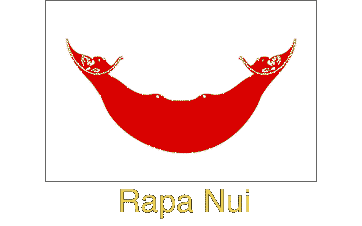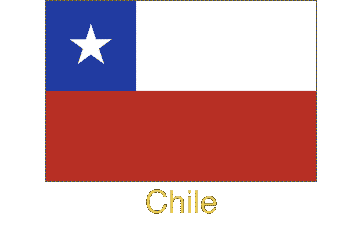Photos from Rapa Nui
| Home | About | Guestbook | Contact |
RAPA NUI (EASTER ISLAND) - 1985
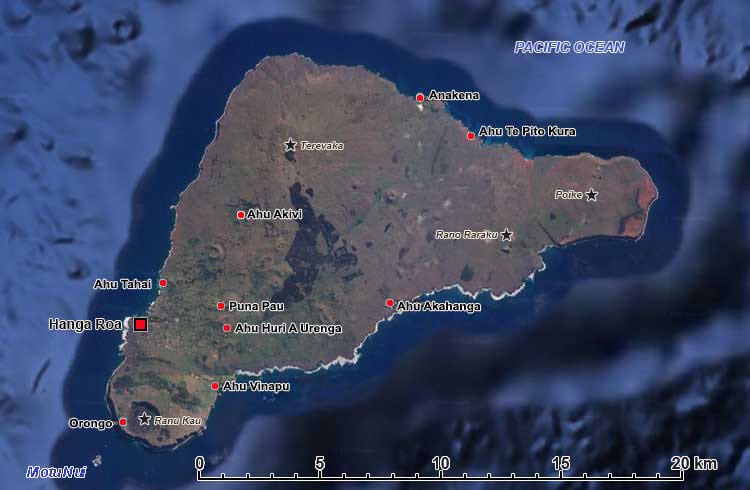
A short history of Rapa Nui (Easter Island)
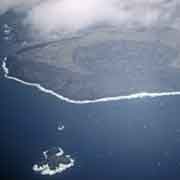
Rapa Nui or Easter Island in the southeastern Pacific Ocean is one of the most remote inhabited islands in the world; its nearest inhabited land is Pitcairn, over 2000 kilometres away. The island is at the south-easternmost point of the Polynesian Triangle in Oceania. It is believed that Easter Island’s Polynesian inhabitants arrived there around 800 to 900 CE, according to oral tradition, in an expedition led by the chief Hotu Matu’a and his captain Tu’u ko Iho. He was the chief of a tribe living in Marae Renga, which is believed was the region of Hiva. It is now assumed they came from Pitcairn, that in those days shared the same people and culture with Mangareva, an island in the French Polynesian Gambier group 540 kilometres to the northwest, from which they had originally come.
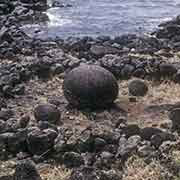
According to legend, a priest named Haumaka appeared to Hotu Matuꞌa in his dreams one night. That priest flew out to sea and discovered an island which he called Te Pito ꞌo te Kāinga, “the centre of the earth”. Hotu Matuꞌa then sent seven scouts, who returned with news the island was good. Hotu Matuꞌa then took his family, a large crew and everything they needed to survive in a single huge double-hulled canoe to “the centre of the earth” and landed at the beach of Anakena, on the north shore of Rapa Nui. The settlement on the island was then founded by Tu’u ko Iho, who, according to legend, “brought the statues to the island and caused them to walk”. Upon Hotu Matu’a’s death, the island was divided among his children, who formed eight main clans. Over time, those clans grouped together into two territories: by the 15th century, there were two confederations (“hanau”), of social groupings (“mata”), based on lineage. In the northwest of the island, lived the Ko Tu’u Aro (Tu’u), who were ruled by the Miru clan, seen as the true royal heirs, whose lands were between Anakena and Hanga Roa. The Hotu Iti (or ‘Otu ‘Itu) clan lived mainly in the southeast part of the island. Both large groups were ruled by leaders claiming divine origin, separating themselves from commoners by taboos and controlling every aspect of life, from religion to food supply to war. And war happened: there developed a fierce competition between the two groups.
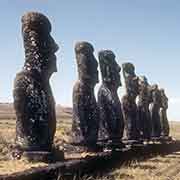
Moai, the now-famous monolithic human statues, were carved between, it is estimated, the years 1000 and mid-eighteenth century. This was a practice common to other people in eastern Polynesia, but nowhere was it done on a scale as on Rapa Nui. It is thought the statues were symbols of authority and power, both religious and political and also actual repositories of sacred spirit. Archaeologists believe that the statues were a representation of the ancestors of ancient Polynesians. They faced away from the ocean and towards the villages as if to watch over the people. They were carved from tuff stone on the slopes of Rano Raraku, the quarry in the northeast of the island; hundreds of them were then transported and set on “ahu”, stone platforms, mostly around the island’s perimeter. Their overly large heads had deep eye sockets, and some originally had coral eyes with either black obsidian or red scoria pupils. The more recent moai had “pukao” on their heads, probably representing the topknot worn by chieftains, suggesting a higher status to the moai. According to local tradition, the mana was preserved in the hair. These pukao were carved out of red scoria, a very light rock from a quarry at Puna Pau. The moai were carved at Rano Raraku, and almost half never left the quarry. They are scattered over the volcanic slope, most buried as far as the shoulders, so that only the enormous heads protrude. One incomplete statue still lies on its back, attached to the rock, in the space carved out around it. It would have been 21.6 metres in height, weighing an estimated 270 tonnes. This would have been more than twice the height of Paro, the tallest moai erected, almost 10 metres high and weighing 82 tonnes. The production and transportation of the more than 900 statues on the island is an incredible, creative and physical feat. William Mulloy (1917-1978), an American anthropologist, developed an idea of how the moai statues could have been transported and erected; but according to tradition, the statues just walked to their ahu. What seems to have happened is that extreme deforestation took place during the time of moai construction. The archeological record shows that at the time before settlement the island was home to many species of trees, including at least three species which grew up to 15 metres or more and at least six species of land birds lived there. Many plant species became extinct after the introduction of the Polynesian rat, but also it has been suggested trees were cut down to be used as rollers to move the statues from their quarry to their ahu.
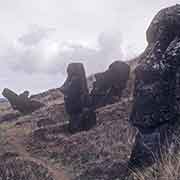
Easter Island’s population had grown to about 15,000 in the 17th century. The pressure on the environment of this small island caused a collapse of its ecology. A combination of over-harvesting of resources, over-hunting, the destruction of plants by rats and a change of climate resulted in the island being largely deforested. Not having large trees meant no canoes could be built, so no fishing. Deforestation also caused erosion, with loss of land suitable for agriculture and the disappearance of all land birds, while the seabird population also collapsed. By the 18th century, the island’s population had dropped to 2,000-3,000, and the people now had to sustain themselves by farming, with domestic chickens their only source of protein. It was during that time that the first Europeans set sight on the island: on 5 April 1722 the Dutch navigator Jacob Roggeveen, with a fleet of three ships and 223 crew, sighted the island they then called “Paasch Eyland” (Easter Island) because when they arrived, it was Easter Sunday. They had set out on an expedition to find Terra Australis, an undiscovered continent thought to exist in the Southern Hemisphere and initially thought they had found it - but soon realised it was only a small island. Roggeveen’s first landing party of 134 men were all heavily armed, as a precaution; tragically due to a misunderstanding, firing broke out, and 10 to 12 islanders were killed and others wounded. Surprisingly, they didn’t retaliate and offered food. The explorers stayed a week on the island and recorded various aspects of Rapa Nui culture and society. Roggeveen noted that the islanders made fires in front of the tall moai. They then squatted on their heels; with bowed heads, they brought their hands together, moving them up and down in front of them.
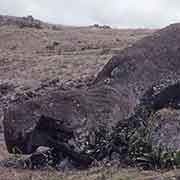
It now seems that in the years that followed, from 1724 until 1750, warfare between the two clans for control of the island erupted: the ‘Oto ‘Itu of the southeast fighting the Tu’u of the northwest. Houses and fields were destroyed, and famine followed. In 1770 another visitor arrived: the navigator Felipe González de Ahedo annexed Easter Island in 1770 on behalf of King Charles III of Spain. He obtained a document, he claimed, on which the islanders had consented, written in their script, called “rongorongo”: unique in Polynesia, it now cannot be deciphered, and doubts exist it was an actual writing system. Following the Spanish visit, chaos and lawlessness on the island continued: groups, competing for power, toppled the statues of their rivals. This “huri mo’ai” meant to destroy the “mana”, the spiritual energy represented by the figures; they intended to break them, so they were dead and powerless. In 1774 the famous British explorer James Cook landed on Easter Island and reported that some statues had been toppled. In 1776 French Admiral Jean-François de Galaup, Comte de Lapérouse anchored at Hanga Roa and mapped the island; but now the islanders were becoming increasingly more aggressive to outsiders, and fewer ships dared to land after that. During the time the island had become overpopulated, a shift in the culture occurred, in which the Ancestor Cult was gradually replaced by the “Bird Man” Cult. It seems to have begun around 1540 when the carving and erection of the moai were coming to an end. The concept of “mana”, power, invested in leaders who inherited it from their fathers, was now recast from the statues, representing the ancestors, into a person, the “Tangata-manu” (Bird Man) who was chosen through a competition. It seems the annual competitions started around 1760. Contestants, men of importance, who had been revealed in dreams by prophets, appointed one or two men of lower status (“hopu”). Those men had to swim to the small island of Motu Nui to collect an egg of the Manu Tara, the sooty tern (Onychoprion fuscatus), a sea bird nesting there, while their sponsors waited in the village of Orongo, high on the cliff. The successful egg finder would call out from the highest point of the island and fast alone; he would then swim back, the egg inside a reed basket tied to his forehead. Reaching land, he would have to climb the steep cliff and present the egg to his patron, who would then be declared the Tangata-manu for the year. It was a dangerous race: many “hopu” were killed by sharks, drowned or fell from the cliffs. The Tangata-manu received foods and tributes and went into seclusion for a year. He was considered “tapu”, sacred and would not engage in any activity apart from eating and sleeping.
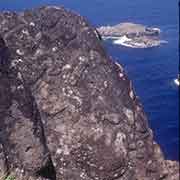
In 1862 Peruvian slave raiders landed and for several months captured and abducted with bribery and great violence about half of the total population of the island, around 1,000 men and women, to take them to the guano mines in the Chincha Islands off the coast of Peru and plantations on the mainland. Among the kidnapped were the ruling king as well as the ritual priests who knew how to read the rongorongo script; today nobody knows. It has been estimated that a total of 2,000 Easter Islanders were captured over the years. Those who survived to arrive in Peru were poorly treated, overworked, and exposed to diseases. Ninety per cent of the Rapanui people died within one or two years of capture. Bishop Florentin-Étienne Jaussen, the first bishop of Tahiti, raised a public outcry and an embarrassed Peru rounded up the few survivors to return them. A shipload headed to Easter Island, but smallpox broke out en route and only 15 arrived at the island. They were put ashore; the survivors spread the disease, to which the people had no immunity. The population soon was reduced to a point where some of the dead were not even buried. In 1864 a Catholic missionary, Brother Eugène Eyraud, a lay friar of the Congregation of the Sacred Hearts of Jesus and Mary, arrived on the island and lived there for nine months, but was not made welcome by the islanders. He left but returned in 1866 and established a Catholic mission there. He was joined by three other missionaries and three converts from Mangareva, whose language had similarities with that spoken on Easter Island. Brother Eyraud was at what would be the last ceremony of the Birdman cult. He told the islanders to abandon their old practices; first opposed, he gradually became popular and influential. But then tuberculosis, that had been introduced by whalers in the mid-19th century broke out again in 1867 and led to the death of a quarter of the island’s population, including the last recognised king, the ‘Ariki Mau Kerekorio Manu Rangi. It killed Eyraud on 23 August 1868, nine days after he had baptised the last islanders. In 1867 a French mariner, Jean-Onésime Dutrou-Bornier, settled on the island. He bought up almost all the lands from the deceased, removed the people and made it into a sheep ranch. It was virtually the whole island, apart from what the missionaries had acquired, around Hanga Roa. He married a woman who was the last heiress of the kings of Easter Island; some of the islanders then recognised him as King Ioane I; he encouraged them to abandon their Christianity and revert to their previous faith. With rifles, a cannon, and hut burning he and his supporters ran the island for several years. He moved a few hundred Rapanui people to Tahiti to work in the coconut plantations for his boss, Alexander Ariipaea Salmon, an English-Jewish-Tahitian co-owner of the Maison Brander plantations on Tahiti.
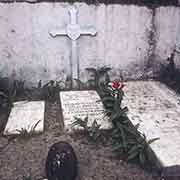
Dutrou-Bonnier and the missionaries clashed, and in 1871 the mission evacuated all but 171 of the remaining Rapanui to Mangareva in the Gambier Islands, leaving mostly older men. In 1877 only 111 people remained on Easter Island: in less than a decade, over 97% of the population had died or had been deported and the island’s cultural knowledge all but lost. In 1876 Dutrou-Bornier died, probably assassinated, and two years later Alexander Ariipaea Salmon set out from Tahiti to Easter Island to manage the Brander sheep station, bringing some of the Rapanui that had been working there and twenty Tahitians. He brought the coconut tree to the island and eventually bought up all the land apart from the Catholic mission. Salmon became the de facto ruler of Easter Island for ten years. He ignored the missionaries, but was an honest man, and sincerely cared about the welfare of the people. The population started to recover. It is probably then that the name of the island, “Rapa Nui”, was coined: hundreds of Rapanui people had been working on Mangareva and Tahiti and had adopted a form of local Tahitian-Pidgin. About 1100 kilometres west of Mangareva and 1000 kilometres southeast of Tahiti is the island of Rapa or Rapa Iti, “Small Rapa”, the southernmost inhabited island of present-day French Polynesia. Easter Island was referred to by the islanders as Te Piti o te Hanua, (“Navel of the World”) but it reminded Tahitian sailors of Rapa Iti, so they called it Rapa Nui, “Big Rapa” and that name stuck. So, during this time, the culture and language of the Rapanui people were strongly influenced by that of Tahiti. Salmon ran the sheep farms, exported wool and developed a tourist industry, encouraging the manufacturing of artworks, to be sold to passing ships. The people greatly respected him. On 2 January 1888 Salmon sold the Brander Easter Island holdings to the Chilean government, and he signed as a witness the cession of the island to the Republic of Chile, 3,686 kilometres away to the east. On 9 September 1888, the island was annexed by a Chilean naval officer, Policarpo Toro, representing the government of Chile, who signed a “Treaty of Annexation of the Island”. It was contra-signed by Atamu Tekena (Atamu te Kena), who had been appointed “King” in 1883 by the Roman Catholic missionaries to represent their interests. Although a member of the Miru clan, traditionally associated with the native kingship, Atamu Tekena was not a royal of the traditional patrilineal line of kings. During the annexation ceremony, he gave Toro a bunch of grass to feed his sheep while he put a handful of soil in his pocket. This symbolised that he gave Chile only the right to use the land, but not the land itself. In the Rapanui language version of the treaty, it only mentioned Chile as a protector; however, in the Spanish version, the island was ceded to Chile in perpetuity.
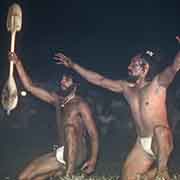
In 1903 the British/Chilean company Williamson-Balfour & Co signed a 50-year lease of the island as a sheep farm, and the surviving Rapanui people were only allowed to stay in Hanga Roa, the only town on the island, while 70,000 sheep roamed freely. A wall with access gates surrounded Hanga Roa, so it became a kind of ghetto for the islanders themselves, who were banned from access to other parts of the island, as well as other fundamental rights. After 1936 they could visit the countryside provided they had written permission from the authorities. The Chilean Navy took over management of the island in 1953. In 1964 a popular uprising led by Alfonso Rapu, a teacher, faced the local administration, demanding an improvement in the living conditions of the Rapanui. Their demands were heard, and in 1965 a civil administration was established on the island. In 1966 the Rapanui people were given Chilean citizenship, and Alfonso Rapu was elected mayor. In 1980 the runway of the airport was lengthened and was now capable of handling wide-body jets. Mataveri International Airport now receives many tourists but also migrants from mainland Chile, threatening the Polynesian identity of the island. Since they received Chilean citizenship in 1966, the Polynesian Rapanui people have embraced their culture again, as far as what they can reconstruct. On 30 July 2007 Easter Island was given the status of a “Special Territory” of Chile; administratively, it belongs to the Valparaíso Region, constituting a single commune of the Province Isla de Pascua. An indigenous rights movement has appeared, and Chile has been criticised for its treatment of the Rapanui people. In 2017, a Chilean census registered 7,750 people on the island, of whom 3,512 (45%) considered themselves Rapanui - a minority on their own island.
